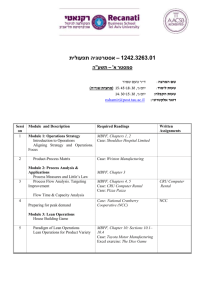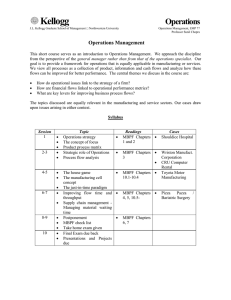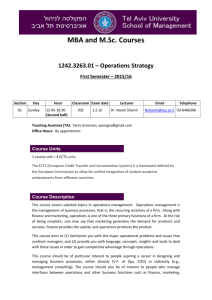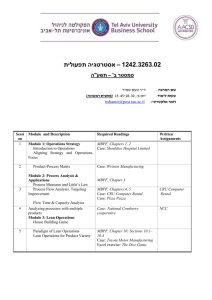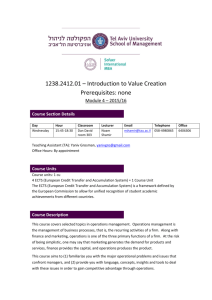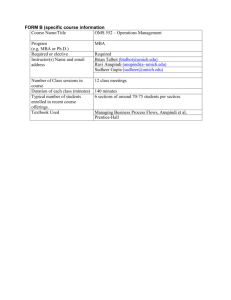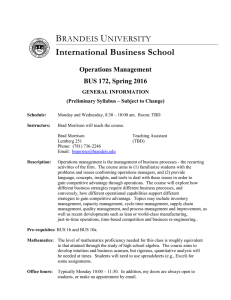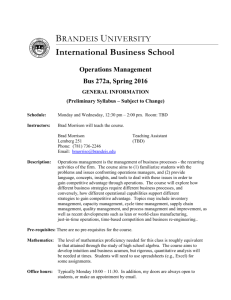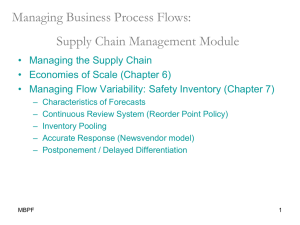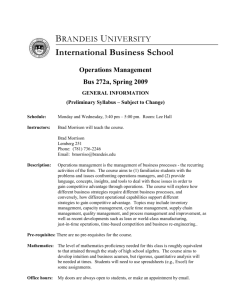Operations 430 P C
advertisement
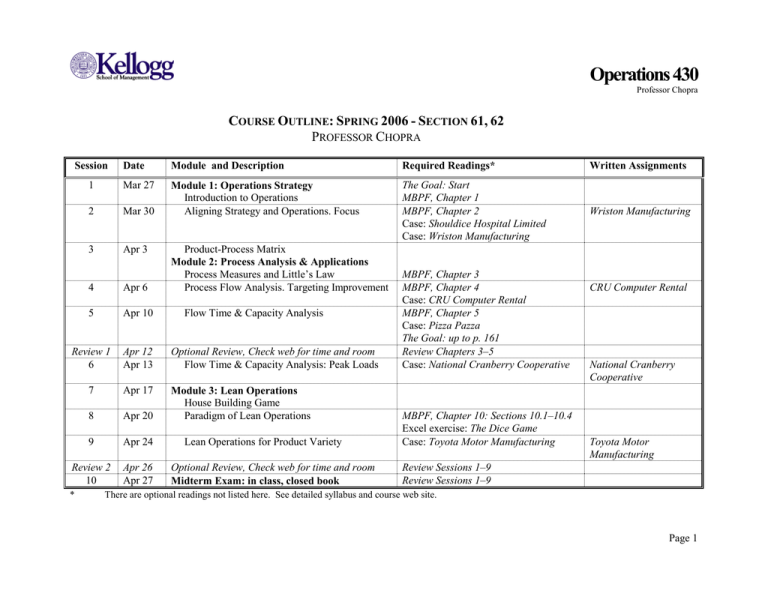
Operations 430 Professor Chopra COURSE OUTLINE: SPRING 2006 - SECTION 61, 62 PROFESSOR CHOPRA Session Date Module and Description Required Readings* Written Assignments 1 Mar 27 2 Mar 30 Module 1: Operations Strategy Introduction to Operations Aligning Strategy and Operations. Focus The Goal: Start MBPF, Chapter 1 MBPF, Chapter 2 Case: Shouldice Hospital Limited Case: Wriston Manufacturing Wriston Manufacturing 3 Apr 3 Product-Process Matrix Module 2: Process Analysis & Applications Process Measures and Little’s Law Process Flow Analysis. Targeting Improvement 4 Apr 6 5 Apr 10 Review 1 6 Apr 12 Apr 13 Optional Review, Check web for time and room Flow Time & Capacity Analysis: Peak Loads 7 Apr 17 8 Apr 20 Module 3: Lean Operations House Building Game Paradigm of Lean Operations 9 Apr 24 Review 2 10 Apr 26 Apr 27 * Flow Time & Capacity Analysis Lean Operations for Product Variety Optional Review, Check web for time and room Midterm Exam: in class, closed book MBPF, Chapter 3 MBPF, Chapter 4 Case: CRU Computer Rental MBPF, Chapter 5 Case: Pizza Pazza The Goal: up to p. 161 Review Chapters 3–5 Case: National Cranberry Cooperative MBPF, Chapter 10: Sections 10.1–10.4 Excel exercise: The Dice Game Case: Toyota Motor Manufacturing CRU Computer Rental National Cranberry Cooperative Toyota Motor Manufacturing Review Sessions 1–9 Review Sessions 1–9 There are optional readings not listed here. See detailed syllabus and course web site. Page 1 Operations 430 Professor Chopra COURSE OUTLINE: SPRING 2006 - SECTION 61, 62 PROFESSOR CHOPRA Session Date Module and Description Required Readings* 11 May 1 Module 4: Supply Chain Management Inventory Basics. Economies of Scale 12 13 May 4 May 8 Uncertainty, Safety Inventory & Pooling Pooling: Centralization & Postponement Review 3 14 15 May 10 May 11 May 15 Optional Review, Check web for time and room Optimal Service Level Module 5: Capacity Management in Services Capacity, Queuing & Flow Time Analysis MBPF, Chapter 6 Case: Palü Gear The Goal: Finish (up to p. 246) MBPF, Chapter 7 (skip Section 7.3) MBPF, Chapter 7: review 7.5–7.7 Case: Shape Up, Ship Out (IBM) Review Chapters 6-7 MBPF, Chapter 7: Section 7.3 MBPF, Chapter 8 Psychology of Waiting Lines 16 17 May 18 May 22 18 May 24 Application to Call Centers Module 6: Quality Quality and Voice of the Customer Process Capability & Statistical Process Control 19 Review 4 20 Final Exam May 25 May 31 June 1 June 3,5,6 * The Value of 6-Sigma Optional Review, Check web for time and room Wrap Up and Review Final Exam: in class, open book. Options: 1. Sat, June 3: 9 am-noon in G40 2. Mon, June 5: noon-3pm in G40 & G45 3. Tue, June 6: noon-3pm in G40 & G45 Case: Sof-Optics (A) MBPF, Chapter 9: Sections 9.1–9.2 Why Improving Quality… MBPF, Chapter 9: Finish Case: Quality Wireless (A), (B) Case: 6-Sigma Quality at Flyrock Tires Review Chapters 8–9, plus all materials Written Assignments IBM Inventory Problem Set Sof-Optics (A) The Goal Review all materials There are optional readings not listed here. See detailed syllabus and course web site. Page 2 Operations 430 Professor Chopra OPERATIONS MANAGEMENT 430 SPRING 2006 - SECTION 61, 62 Instructor: Sunil Chopra; s-chopra@kellogg.northwestern.edu Phone: 847.491.8169. Fax: 847.467.1220 Office: Jacobs 573 (MEDS Department). Office Hours: Wednesdays: You can go to any of the following (all in MEDS dept.). Please make an effort to come to my office hours before going to another instructor. Prof. Chopra: 9:00 – 10:30 Prof. Savaskan: 10:30 – 12:00 Prof. Ata: 13:00 - 14:30 Prof. Van Mieghem: 14:30 – 16:00 Course Page: http://www.kellogg.northwestern.edu/faculty/chopra/ftp/omd30/d30.html Course Description and Objectives This course provides a general introduction to operations management. Operations management is the management of business processes, that is, the recurring activities of a firm. Along with finance and marketing, operations is one of the three primary functions of a firm. At the risk of being simplistic, one may say that marketing generates the demand for products and services, finance provides the capital, and operations produces the product. More generally, operations spans the entire organization: COOs are in charge of R&D, design/engineering, production operations, marketing, sales, support and service. This course aims to (1) familiarize you with the major operational problems and issues that confront managers, and (2) provide you with language, concepts, insights and tools to deal with these issues in order to gain competitive advantage through operations. This course should be of particular interest to people aspiring a career in designing and managing business processes, either directly (V.P. of Ops, COO) or indirectly (e.g., management consulting). The course should also be of interest to people who manage interfaces between operations and other business functions such as finance, marketing, managerial accounting and human resources. Finally, a working knowledge of operations, Operations 430 Professor Chopra which typically employs the greatest number of employees and requires the largest investment in assets, is indispensable for general managers and entrepreneurs. We will see how different business strategies require different business processes, and vice versa, how different operational capabilities allow and support different strategies to gain competitive advantage. A process view of operations will be used to analyze different key operational dimensions such as capacity management, flow time management, supply chain management, and quality management. We will also discuss developments such as lean operations, just-in-time operations, and time-based competition. Required Texts Required materials available at the bookstore: 1. 2. 3. 4. Course pack Part I: cases and readings (common across all instructors). Course pack Part II: overhead slides (separate for each instructor). The Goal by Goldratt and Cox. North River Press, 2nd edition, 1992. Managing Business Process Flows (MBPF) by Anupindi, Chopra, Deshmukh, Van Mieghem and Zemel. Prentice Hall, 2nd edition, 2005. As a novel, The Goal is light reading and some sections are quite entertaining. Nevertheless, it has over 300 pages, so you are encouraged to start reading now. We will draw on it during the entire course. You will be asked to hand-in your main take-away’s near the end of the course. Grading The grade you receive for the course is intended to certify your demonstrated proficiency in the course material. Proficiency will be estimated by measuring your performance on (1) class contribution, (2) homeworks and (3) exams. The midterm exam will be in class, closed book. You may use your laptop as a calculator. It will be held during regular class session 10. The final will be a three-hour, in-class exam with open readings, open class handouts and notes. It will be comprehensive, covering material from all course modules. Your course grade will be based on a weighted evaluation of the following categories: 1. 2. 3. 4. Class contribution Case write-ups Midterm examination Comprehensive final examination 10% 20% 30% 40% 4 Operations 430 Professor Chopra Assignments The course assignments are designed to engage you in the issues, to teach you ways to think about and analyze operational problems, and to prepare you to be effective managers. The enclosed course outline and detailed schedule provides you, class by class, with a brief description of the class, the readings and case preparation questions (if any). As part of your class preparation, please consider how you would answer each of the discussion questions. The readings and assignments should require an average of about three to four hours of preparation per class meeting. If you find yourself averaging more preparation time per session, please let me know. (Typically, students find the class load high in the first three weeks. As you become more comfortable with the material, this subjective assessment will change for the better.) Case Write-Ups Each case write-up should address the question in italics that goes with the case assignment. In preparing your write-up, please adhere to the following guidelines: Be concise and well-structured: Recommendations should be summarized on 1 page and be complemented by a crystal clear discussion of how these follow from your analysis (another 1-2 pages, not including exhibits). Be to the point: Know that you write to someone who knows the facts of the case; focus on your explaining, and making a clear case for, your recommendations. Be punctual: Late submissions will not be accepted. All case write-ups may be done in groups that ideally have five persons—to strike a balance between benefits derived from teamwork and cost due to increased logistical complexity. The honor code stipulates that you may put your name on the submission only if you contributed to the group discussion. A peer evaluation at the end of the quarter will be used before finalizing homework grades at the individual level. Some cases (e.g., Cranberry and SofOptics) are detailed and more open-ended. You should use your team’s judgment to figure out how to tackle those cases; however, you should not spend more than 3 team-hours in preparing most cases. The entire goal behind the team approach to case preps is to have you think and experiment, and to sensitize you to those issues that are novel and should be further discussed in class. Class Contribution In-class contribution will consist mainly of voluntary contributions, although I may call upon students to encourage broader participation. (Although cold calling may increase anxiety, the GMA suggests that “supportive” cold calling encourages you to be better 5 Operations 430 Professor Chopra prepared for class and as a result improves the overall class discussion.) Every group will be required to have at least one substantial posting (will be described in class) on the course newsgroup. Review Sessions and Use of the Web The course web site http://www.kellogg.northwestern.edu/faculty/chopra/ftp/omd30/d30.html will be used to facilitate course progression. It contains information on: Office hours. Review session schedule: There will be four review sessions. Each session will discuss some quantitative problems from the book. MBPF textbook exercises and solutions. Sample midterm and final exam questions & solutions. Software downloads for cases. Discussion group. Announcements. As the course progresses and before any case assignment is due, please check your email and the course web page for files (spreadsheets, etc.) and any announcements. Suggested Readings None of these readings are a requirement for the course. Nonetheless, you may find them interesting. The books are non-technical in nature. 1. The Machine that Changed the World: The Story of Lean Production by James P. Womack, Daniel T. Jones and Daniel Roos, Harper Perennial, 1991. 2. The Discipline of Market Leaders by Treacy and Wiersema, Addison Wesley, 1997. 3. Plant and Service Tours in Operations Management by Roger W. Schmenner, Fourth edition, Macmillan Publishing Company, 1994. 6 Operations 430 Professor Chopra Module 1: Operations Strategy Class 1: Introduction to Operations Objective: Characterize “operations management” and its link to business strategy to gain competitive advantage. Required Reading: MBPF, Chapter 1. The Goal: start reading (there will be an assignment in Class 18.) Optional Reading: What is Strategy? Preparation Questions: 1. In a business context, what is meant by operations? 2. What are the competitive priorities of a typical (service or manufacturing) business? 3. What role does operations management play in achieving these? Class 2: Aligning Strategy and Operations. Focus Objective: Illustrate how to do a strategic operational audit to align strategy and operations. Discuss the notion of focused operations, its advantages and challenges. Required Reading: MBPF, Chapter 2. Optional Reading: The Focused Factory. Case: Shouldice Hospital. Be prepared to discuss the following questions: 1. Apply the process view to Shouldice Hospital: what are the key process features? 2. What are Shouldice’s competitive priorities? What kind of market have they chosen to focus on? How does their operations strategy support their business strategy? Written Assignment: Wriston Corporation: The Detroit Plant. Write-up should address the italicized question: 1. Why do overhead costs (Exhibit 2) vary so greatly from plant to plant in Wriston’s manufacturing network? 2. Why have managers in the Heavy Equipment Division under-invested in the Detroit Plant? 3. What should Richard Sullivan do with the Detroit Plant? Justify your recommendation. 7 Operations 430 Professor Chopra Module 2: Process Analysis and Applications Class 3: Product-Process Matrix (Module 1). Process Measures and Little’s Law Objective: Discuss process types, their characteristics and the product-process matrix (this wraps up Module 1). Introduce the fundamental process measures throughput, inventory and flow time, and Little’s Law, the key relationship among the three. Required Reading: MBPF, Chapter 3. Optional Reading: Time - The Next Source of Competitive Advantage. Class 4: Process Flow Analysis. Targeting Improvement Objective: Discuss where to target improvement using process flow charts and fundamental process performance measures such as flow time, inventory and throughput. Required Reading: MBPF, Chapter 4. Written Assignment: CRU Computer Rentals. We will discuss the questions listed at the end of the case in class. Address the following questions in your write-up: 1. What is the process at CRU? Make a flow chart clearly identifying activities, routes and any other data given in the case. Bring a transparency of your flow chart to class. 2. What do you think about the decision to launch a sales drive this year? 3. What actions would you suggest Richard focus on to improve performance at CRU? Make concrete recommendations and indicate anticipated benefits. 4. What are the key performance measures Richard should focus on? Note: your qualitative discussion should be backed by quantitative analysis. Class 5: Flow Time & Capacity Analysis Objective: Discuss the drivers of flow time and capacity. Required Reading: MBPF, Chapter 5. The Goal: at least up to p. 161. Case: Pizza Pazza. Prepare questions attached to case. There is no assignment due. 8 Operations 430 Professor Chopra Class 6: Flow Time & Capacity Analysis: Peak Loads Objective: Reinforce and extend the concepts discussed in Classes 3-5 to settings with temporary excess demand and show how to apply them to guide capacity investment decisions. Written Assignment: National Cranberry Cooperative. This is a challenging case, please allocate sufficient amount of time (which will be made up for next week). Consider the following questions for discussion. Write-up should address the italicized question: 1. Draw a detailed process flow map of the current process at Receiving Plant #1. What is the capacity of each process step? 2. What is the maximum long-term achievable throughput rate of Receiving Plant #1? What factors affect this throughput rate? 3. Currently what is (are) the major reason(s) for trucks waiting and excessive overtime? 4. On average, how long will the trucks have to wait on a busy day? Assume a 7am start of processing of berries and a continuous arrival rate of berries of 1,500bbls/hr. 5. What benefits would you expect if processing time was moved up from 11:00 a.m. to 7:00 a.m. during the peak period? Should this be done for the entire season? 6. What are your recommendations to NCC on how to deal with their problems? Assume that drivers are paid $5 per hour and that an average busy day has a continuous arrival rate of berries of 1,500bbs/hr. (You may assume 100% bulking on busy days.) You may use the Excel workbook NCC.xls (available on the course page) to analyze this case, although the analysis can be done without it. Recommended problems: 4.1, 4.2, 4.4, 4.6 (flow time); 5.1, 5.2, 5.4 (capacity). Module 3: Lean Operations Class 7: House Building Game Objective: Explore the relationship between process structure and performance (cost, quality and time) through a team-based simulation game. 9 Operations 430 Professor Chopra Class 8: Paradigm of Lean Operations Objective: Introduce, drawing on your house game experience, the paradigm of lean operations with its focus on attaining an ideal process through waste reduction. Required Reading: MBPF, Chapter 10: Sections 10.1 – 10.4. Interactive exercise: The Dice Game from The Goal, available in two versions. Point your browser (Internet Explorer) to: www.kellogg.northwestern.edu/faculty/chopra/ftp/omd30/leanoperations/dicegame/pageone.htm Class 9: Lean Operations for Product Variety Objective: Study the major components of the Toyota Production System and critically assess the costs and benefits. Discuss its application to an environment with product variety. Interactive exercise: Value of Setup Time Reduction (Midwest Molding). Point your browser (Internet Explorer) to (documentation is in the course packet): http://www.kellogg.northwestern.edu/faculty/chopra/ftp/omd30/leanoperations/changeover. xls Written Assignment: Toyota Motor Manufacturing USA. Prepare the following questions for discussion. Write-up should address the italicized question: 1. Identify if, and if so where, Toyota carries inventory and excess capacity. 2. a) What is the cost of an average chord pull resulting in a stoppage of 1 minute, 30 minutes, or 60 minutes? b) Based on your financial estimate, what is your qualitative assessment of the practice of letting employees stop the line? c) Now, focusing on seats only: Do you think the line should be stopped when the station identifies a defective seat? Note: only part a) is quantitative; both parts a) & b) relate to an average chord pull at any station; only part c) deals with the seat problem only. 3. What is the value of a cord pull? What actions does Toyota take to lower the cost of a line stoppage? Class 10: Midterm Exam The midterm exam will be in class, closed book during our regular class session. You may use your laptop as a calculator. Recommended preparation: 1. Sample midterm exam (see course page). 2. MBPF examples and exercises, especially the recommended & review problems. 10 Operations 430 Professor Chopra Module 4: Supply Chain Management Class 11: Inventory Basics. Economies of Scale & Cycle Inventory Objective: Introduce the roles of inventory for business. Discuss how to manage cycle inventories to exploit economies of scale. Required Reading: MBPF, Chapter 6. The Goal: finish (you can stop at page 246.) Case: Palü Gear. Questions 1.a & 1.b. There is no assignment due. Recommended problems: 6.2, 6.4, 6.5, 6.10. Class 12: Uncertainty, Safety Inventory & Pooling Objective: Discuss forecasting characteristics and how to manage safety inventory to protect against uncertainty in demand and/or supply lead times. Discuss the concept of inventory “pooling” and its role in supply chain design. Required Reading: MBPF, Chapter 7 (skip Section 7.3) Case: Questions 1.c & 1.d. There is no assignment due. Palü Gear. Recommended problems: 7.1, 7.2. Class 13: Pooling: Centralization & Postponement Objective: Discuss different pooling methods, particularly centralization and postponement, their pros and cons, and implications for supply chain design. Required Reading: MBPF, Chapter 7: review Sections 7.5-7.7 Recommended problems: 7.3, 7.8, 7.9. Written Assignment: Shape Up, Ship Out (IBM). Write-up should address the italicized questions: 1. Identify the key value drivers behind the various supply chain strategies that IBM considered. Why and when is a particular supply chain design preferable? 2. Identify other industries where similar ideas can be (or are) used. 11 Operations 430 Professor Chopra Class 14: Optimal Service Level. Objective: Discuss the “newsvendor” model, a simple but important methodology for determining the optimal order quantity and level of product availability, in the context of short-life cycle products, e.g., fashion goods, whose value quickly decay over time. Required Reading: MBPF, Chapter 7: Section 7.3 Case: Question 2. There is no assignment due. Palü Gear. Recommended problems: 7.4, 7.5. Module 5: Capacity Management in Services Class 15: Capacity, Queuing & Flow Time Analysis Objective: Introduce queuing phenomena and discuss managerial actions that mitigate queuing’s negative impact on operational performance. Required Reading: MBPF: Chapter 8. The Psychology of Waiting Lines. Interactive exercise: Queuing Experiment. Excel spreadsheet available under “Capacity Management in Services”. Point your web browser (Internet Explorer) to: http://www.kellogg.northwestern.edu/faculty/VanMieghem/ftp/430/queue-performance.xls Recommended problems: 8.1, 8.4, 8.5, 8.8. Written Assignment: Inventory Problem Set (as always: to be done in team). 12 Operations 430 Professor Chopra Class 16: Applications: Financial Evaluation of a Call Center Objective: Show how queuing theory can be used as a tool for managing service operations facing time-sensitive customers. Sof-Optics (A). Prepare the following questions: 1. What are the major problems being encountered in the Customer Service Department? What is their strategic significance? 2. What are the key performance measures for the Computer Service Department? What level of service is appropriate for the department? 3. Conduct a capacity analysis of the CS department. How many calls per hour can they handle and do they need to handle on an average day, and under peak load conditions? Written Assignment: Sof-Optics (A). Submit a brief write-up answering: 4. Estimate the annual opportunity costs due to poor service. You should identify (in English) the main sources of losses and how to calculate them. For each source: discuss how you estimate relevant data and show your financial estimate. Specifically: limit your analysis to lost margin on an annual basis for poor service between 10am and 2pm. Assume that callers abandoning or receiving a busy signal are all lost and do not call back. Clearly state any other assumptions that you use. 5. Briefly discuss your recommendations for improvement. You may want to use the Excel workbook Queue-performance.xls to analyze this case. Note: - The spreadsheet only takes integers as inputs. - K = number of calls that can be put on hold, excluding calls that are being served. - Use your judgment and detective work to distill spreadsheet inputs from the case data. Module 6: Quality Management Class 17: Quality and Voice of the Customer Objective: Discuss the different connotations of “quality”. The first step in strategic quality management is to map “the voice of the customer” into design and operational specifications. Required Reading: MBPF, Chapter 9: Sections 9.1 - 9.2. Why Improving Quality Doesn’t Improve Quality. 13 Operations 430 Professor Chopra Class 18: Process Capability & Statistical Process Control Objective: The second step in strategic quality management is to determine the current process capability and plans for improvement. Once the plans are implemented, a manager needs to “check” that improvement has actually taken place. Finally, a manager needs mechanisms to verify that the process continues to provide improved performance. In this context we introduce statistical process control. Required Reading: MBPF, Chapter 9: Finish. Case: Quality Wireless (A) and (B). Prepare the questions attached to case. There is no assignment due. Suggestion: Experiment with Greasex Inc workbook. Using Internet Explorer, go to: www.kellogg.northwestern.edu/faculty/chopra/ftp/omd30/quality/greasex/frameset1.htm Written Assignment: The Goal. Summarize your main take-away’s (“what is worthwhile remembering 5 years from now?”) and critically assess their value and usefulness. Class 19: The Value of 6-Sigma Objective: Discuss the benefits from continuous process improvement. Case: 6-Sigma Quality at Flyrock Tires. Prepare the questions attached to case. There is no assignment due. Use Internet Explorer to step through the web version of the case: www.kellogg.northwestern.edu/faculty/chopra/ftp/omd30/quality/flyrock/story0.htm Recommended problems: 9.1, 9.2, 9.7, 9.9. Class 20: Wrap Up and Review No readings. Final Exam: The final exam will be in class, open book over 3 hours. You may use a PC and any spreadsheets used in the course. Recommended preparation: 1. Sample final exam (see web page) 2. MBPF examples and exercises, especially the recommended & review problems. 14
